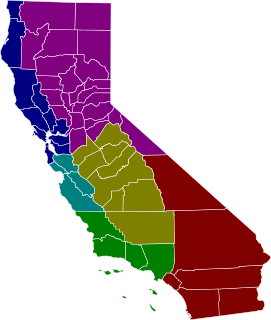In the United States, a state supreme court is the ultimate judicial tribunal in the court system of a particular state. On matters of state law, the decisions of a state supreme court are considered final and binding on state and even United States federal courts.

The Appellate Divisions of the Supreme Court of the State of New York are the intermediate appellate courts in New York State. There are four Appellate Divisions, one in each of the state's four Judicial Departments.

The New Hampshire Supreme Court is the supreme court of the U. S. state of New Hampshire and sole appellate court of the state. The Supreme Court is seated in the state capital, Concord. The Court is composed of a Chief Justice and four Associate Justices appointed by the Governor and Executive Council to serve during "good behavior" until retirement or the age of seventy. The senior member of the Court is able to specially assign lower-court judges, as well as retired justices, to fill vacancies on the Court.

The Supreme Court of California is the highest and final court in the courts of the State of California. It resides inside the Earl Warren Building in San Francisco, overlooking Civic Center Square along with City Hall. It also holds sessions in Los Angeles and Sacramento. Its decisions are binding on all other California state courts.

The Supreme Court or simply referred to by its colloquial name as Korte Suprema, is the highest court in the Philippines. The Court was established by the second Philippine Commission in June 11, 1901 through the enactment of Act No. 136, an Act which had abolished the Real Audiencia de Manila.

The Supreme Court of Florida is the highest court in the U.S. state of Florida. It consists of seven members—the chief justice and six justices. Five members are chosen from five districts around the state to foster geographic diversity and two are selected at-large.

The Supreme Court of Nevada is the highest state court of the U.S. state of Nevada, and the head of the Nevada Judiciary. The main constitutional function of the Supreme Court is to review appeals made directly from the decisions of the district courts. The Supreme Court does not pursue fact-finding by conducting trials, but rather determines whether legal errors were committed in the rendering of the lower court's decision. While the Court must consider all cases filed, it has the discretion to send appeals to the Nevada Court of Appeals for final resolution, as well as the power to determine the jurisdiction of that court.

The Connecticut Supreme Court, formerly known as the Connecticut Supreme Court of Errors, is the highest court in the U.S. state of Connecticut. It consists of a Chief Justice and six Associate Justices. The seven justices sit in Hartford, across the street from the Connecticut State Capitol. It generally holds eight sessions of two to three weeks per year, with one session each September through November and January through May. Justices are appointed by the governor and then approved by the Connecticut General Assembly.

The California Courts of Appeal are the state intermediate appellate courts in the U.S. state of California. The state is geographically divided into six appellate districts. The Courts of Appeal form the largest state-level intermediate appellate court system in the United States, with 105 justices.

The Supreme Court of Georgia is the highest judicial authority of the U.S. state of Georgia. The court was established in 1845 as a three-member panel. Since 1896, the justices have been elected by the people of the state. The justices are currently elected in statewide non-partisan elections for six-year terms, with any vacancies filled through an appointment by the Governor.

Isaac Newton Blackford was the second Chief Justice of the Indiana Supreme Court, the court's longest serving Justice, and among the longest serving jurists in the history of the United States. He wrote an eight-volume work entitled Blackford's Reports recording all the early decisions of the court. The books became a staple legal source among Indiana's lawyers and received national and international acclaim for its style, accuracy, quality, and concision in dealing with common law. As a jurist, Blackford was the most influential ever to serve on Indiana's courts, according to former Chief Justice of Indiana Randall Shepard. He was nicknamed the "Indiana Blackstone" because of a comment made by Washington Irving regarding the popularity of Blackford's books. During his lifetime he was nationally renowned as one of the most prominent jurists in the United States.
The supreme court is the highest court within the hierarchy of courts in many legal jurisdictions. Other descriptions for such courts include court of last resort, apex court, and highcourt of appeal. Broadly speaking, the decisions of a supreme court are not subject to further review by any other court. Supreme courts typically function primarily as appellate courts, hearing appeals from decisions of lower trial courts, or from intermediate-level appellate courts.

The Montana Supreme Court is the highest court of the Montana state court system in the U.S. state of Montana. It is established and its powers defined by Article VII of the 1972 Montana Constitution. It is primarily an appellate court which reviews civil and criminal decisions of Montana's trial courts of general jurisdiction and certain specialized legislative courts, only having original jurisdiction in a limited number of actions. The court's Chief Justice and six Associate Justices are elected by non-partisan, popular elections. The Montana Supreme Court meets in the Joseph P. Mazurek Building in Helena, Montana, the state's capital, an international style building completed in 1982 and named in the honor of former Montana Attorney General, Joseph P. Mazurek.
The Government of Guam (GovGuam) is a presidential representative democratic system, whereby the President is the head of state and the Governor is head of government, and of a multi-party system. Guam is an organized, unincorporated territory of the United States with policy relations between Guam and the US under the jurisdiction of the Office of Insular Affairs.

Steven H. David is the 106th Justice of the Supreme Court of Indiana. David previously served as a lawyer and military officer. He retired from the United States Army Reserve in September 2010 with the rank of colonel.
The Indiana Judicial Nominating Commission, which also serves as the Indiana Judicial Qualifications Commission, is a panel consisting of the Chief Justice of the Indiana Supreme Court and six other members chosen by those admitted to practice law in Indiana and by the Governor of Indiana to select judges to serve on the Indiana Court of Appeals and the Indiana Supreme Court. The commission is part of the Judicial Branch of the state government and reports directly to the state Supreme Court.
Richard M. Givan (1921–2009) served as the 96th Justice of the Indiana Supreme Court from January 6, 1969 until his retirement December 31, 1994. He served as Chief Justice from 1974 until March 1987.

The Judiciary of California is defined under the California Constitution, law, and regulations as part of the Government of California. The judiciary has a hierarchical structure with the Supreme Court at the apex, California courts of appeal as the primary appellate courts, and the California superior courts as the primary trial courts. Its administration is effected by the Judicial Council and its staff, as well as the relatively autonomous courts. California uses a modified Missouri Plan method of appointing judges, whereby judges are nominally elected at the superior court level and appointed at higher levels, and are subject to retention elections.
The Judiciary of Illinois is the unified court system of Illinois responsible for applying the Constitution and law of Illinois. It consists of the Supreme Court, Appellate Court, and circuit courts. The Supreme Court oversees the administration of the court system.
Justin Brett Busby is a current Justice of the Supreme Court of Texas and a former Justice of the Fourteenth Court of Appeals of Texas whose six-year term ended December 31, 2018. Along with many other Republican incumbents on the State's largest intermediate appellate courts, Busby was defeated in the November 2018 Democratic sweep.






















